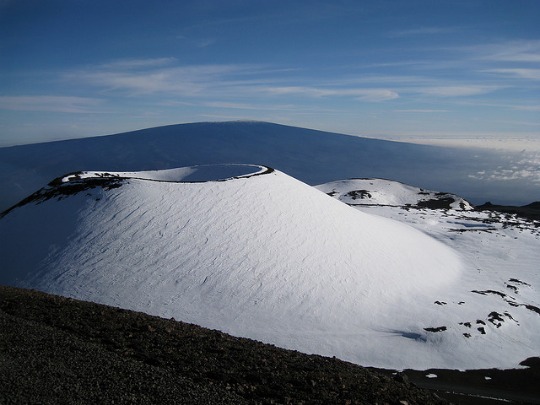
Mauna Loa (as seen from nearby Mauna Kea) is tall enough to have snow, at least when the volcano isn't erupting (courtesy of flickr user superfluity)
(1) Olympus Mons - 15.5 miles
The largest volcano on Mars is also the solar system’s tallest mountain. Measuring 374 miles in diameter, it covers about the same amount of land as the state of Arizona. Olympus Mons is located near three other volcanoes known as the Tharsis Montes. The volcanoes in this area are all 10 to 100 times bigger than Earth’s largest volcanoes. They can get this big because, unlike on Earth, there are no plate tectonics on Mars that can drag a volcano away from its hotspot–they just sit in one volcanically active place and grow bigger and bigger.
(2) Rheasilvea Mons – 13.2 miles
Rheasilvea, on the asteroid Vesta, sits at the center of a 300-mile wide crater. The asteroid is currently the subject of a close study by the spacecraft Dawn, which will continue to circle it through the first half of 2012 before moving on for a rendezvous with the asteroid Ceres in 2015. Rheasilvea Mons sometimes gets named the tallest peak in the solar system, but even with satellites and spacecraft monitoring faraway planets, moons and asteroids, measuring these things is rather difficult (which should explain why the numbers for heights given here may differ from what you’ve seen elsewhere–sources often disagree).
(3) Equatorial Ridge of Iapetus – 12.4 miles
Saturn’s moon of Iapetus has a couple of weird features. The first is a huge crater that gives the moon the appearance of the Death Star from Star Wars. The second is an equatorial ridge, with some peaks reaching over 12 miles high, that makes Iapetus look like a walnut. Scientists aren’t quite sure how the ridge formed, but they have hypothesized that it was either the remnant of the moon’s earlier oblate shape, icy material pushed up from beneath the moon’s surface or even the remainder of a collapsed ring.
(4) Ascreaus Mons – 11.3 miles
This volcano on Mars is the tallest of the three volcanoes known as the Tharsis Montes, which appear in a straight line near Olympus Mons. Ascreaus Mons has a central caldera that is 2.1 miles deep. It was first spotted by the Mariner 9 spacecraft in 1971 and then named the North Spot, as it appeared as a spot in a dust storm photographed by the spacecraft. Later images revealed it was a volcano and the spot was remaned.
(5) Boösaule Montes – 10.9 miles
Boösaule Montes is a collection of three mountains on Io, a moon of Jupiter, all connected by a raised plain. The mountain termed “South” is the tallest of the three. One side of the mountain has such a steep slope, 40 degrees, that scientists think that it was the site of a huge landslide.
(6) Arsia Mons – 9.9 miles
This is second tallest volcano from the Tharsis Montes on Mars. Based on the discovery of certain geological features on the volcano, scientists think that Arsia Mons may be home to glaciers.
(7) Pavonis Mons – 8.7 miles
Pavonis Mons is the shortest of the three volcanoes that make up the Tharsis Montes, and it has also been suggested to be home to glaciers.
(8) Elysium Mons - 7.8 miles
This Martian volcano is a big fish in a little pond, metaphorically speaking. It is the tallest volcano in the Elysium Planitia, a region in Mars’ Eastern Hemisphere that is the second largest volcanic system on the planet.
(9) Maxwell Montes - 6.8 miles
This mountain range on Venus stretches for 530 miles. Scientists aren’t sure how the mountains formed, but they think they are home to large amounts of fool’s gold (iron pyrite).
(10) Mauna Loa – 5.7 miles
Earth just squeaks into this top ten list with this active volcano on the island of Hawaii (remember, mountains are measured from their base to their peak, and Mauna Loa’s base is far beneath the ocean surface). Mauna Loa is one of many active and dormant volcanoes created by a hotspot beneath the Pacific Ocean plate. As the plate moves over the hotspot, which has been active for at least 30 million years, new islands begin to form and old ones, no longer being built up through volcanic activity, whither wither away.
ليست هناك تعليقات:
إرسال تعليق